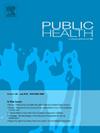对患有酒精相关肝病或代谢相关脂肪肝的澳大利亚人进行肝癌死亡一级和二级预防的潜力:模型研究
IF 3.9
3区 医学
Q1 PUBLIC, ENVIRONMENTAL & OCCUPATIONAL HEALTH
引用次数: 0
摘要
目的肝细胞癌(HCC)是最常见的原发性肝癌,在澳大利亚的发病率和死亡率都在上升,而酒精摄入过量、超重和肥胖造成的比例也在上升。酒精相关性肝病(ARLD)或代谢功能障碍相关性脂肪性肝病(MASLD)患者是高危人群,但通过减肥、戒酒和常规监测来预防可降低 HCC 死亡的可能性。研究设计模拟建模研究。方法对现有的肝病 Policy1-Liver 模型进行了扩展,以捕捉 ARLD 和 MASLD 患者的疾病进展情况。对减肥干预、戒酒以及使用 FIB-4、瞬态弹性成像和超声波进行常规 HCC 监测进行了模拟,并估算了对 HCC 负担和成本的影响。通过这一干预措施,每年可预防多达 417 例澳大利亚 HCC 死亡。常规HCC监测可将ARLD相关HCC死亡风险降低18.6%,将MASLD相关HCC死亡风险降低18.1%,每年最多可预防254例澳大利亚MASLD和ARLD相关HCC死亡。结论减肥、戒酒和常规 HCC 监测可改善 ARLD 或 MASLD 患者的健康状况。建立模型以支持具有成本效益的预防,有助于指导澳大利亚肝癌控制方面的政策决策和未来投资。本文章由计算机程序翻译,如有差异,请以英文原文为准。

The potential for primary and secondary prevention of liver cancer death in Australians with alcohol-related liver disease or metabolic-associated steatotic liver disease: A modelling study
Objectives
Hepatocellular carcinoma (HCC), the most common form of primary liver cancer, is increasing in incidence and mortality in Australia, and the proportion attributable to excess alcohol intake, overweight and obesity is rising. People with alcohol-related liver disease (ARLD) or metabolic dysfunction-associated steatotic liver disease (MASLD) are at high risk, but prevention via weight loss, alcohol cessation, and routine surveillance can reduce the likelihood of HCC death. We aimed to estimate the potential for HCC prevention in Australians with ARLD and MASLD.
Study design
Simulation modelling study.
Methods
The existing Policy1-Liver model of liver disease was extended to capture disease progression in people with ARLD and MASLD. A weight loss intervention, alcohol cessation, and routine HCC surveillance using FIB-4, transient elastography, and ultrasound were simulated, and the impacts on HCC burden and costs were estimated.
Results
A once-off 10% weight loss intervention would reduce risk of MASLD-related HCC death by 25.9%. Up to 417 Australian HCC deaths would be preventable annually through this intervention. Alcohol cessation could double quality-adjusted life expectancy of people with ARLD.
Routine HCC surveillance would reduce ARLD-related HCC death risk by 18.6 % and MASLD-related HCC death risk by 18.1%, and prevent up to 254 MASLD- and ARLD-related HCC deaths in Australia annually. Surveillance would be cost-effective, except for those with early-stage MASLD.
Conclusions
Weight loss, alcohol cessation, and routine HCC surveillance can improve health outcomes for people with ARLD or MASLD. Modelling to support cost-effective prevention can help guide policy decisions and future investment in liver cancer control in Australia.
求助全文
通过发布文献求助,成功后即可免费获取论文全文。
去求助
来源期刊

Public Health
医学-公共卫生、环境卫生与职业卫生
CiteScore
7.60
自引率
0.00%
发文量
280
审稿时长
37 days
期刊介绍:
Public Health is an international, multidisciplinary peer-reviewed journal. It publishes original papers, reviews and short reports on all aspects of the science, philosophy, and practice of public health.
 求助内容:
求助内容: 应助结果提醒方式:
应助结果提醒方式:


